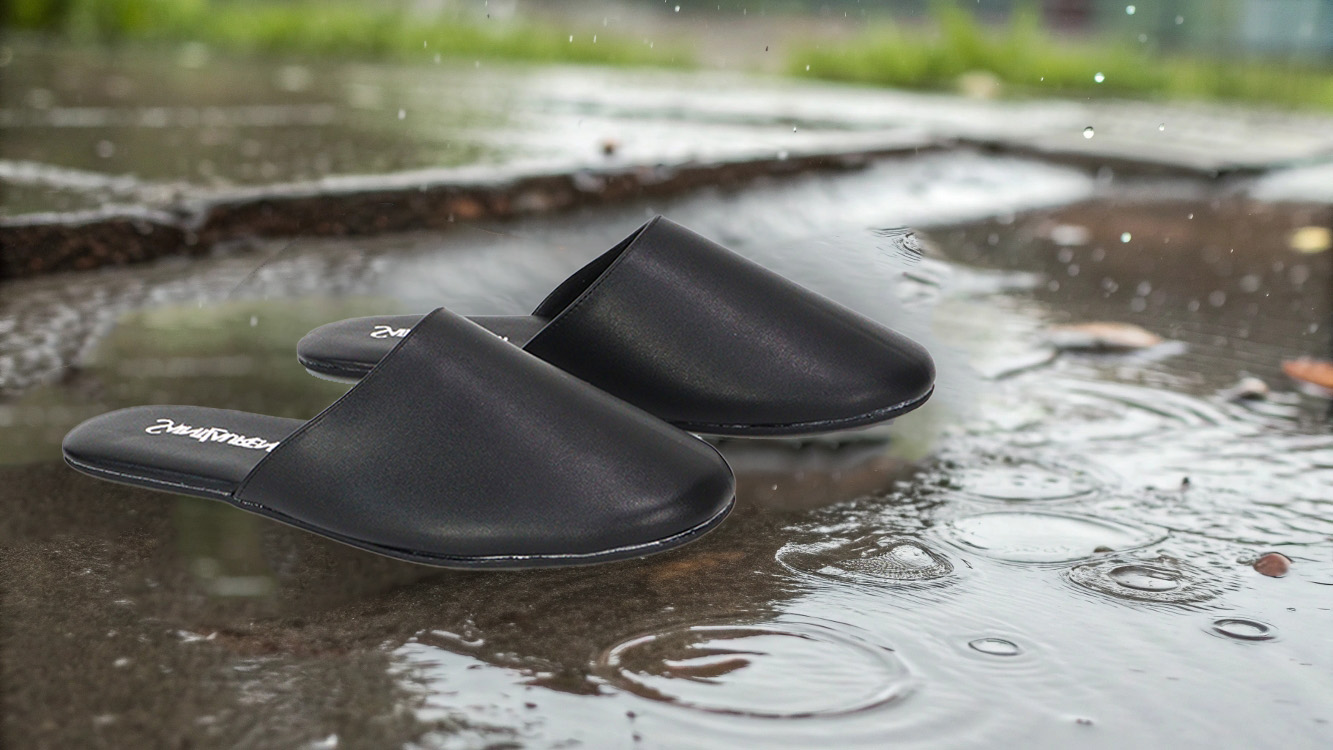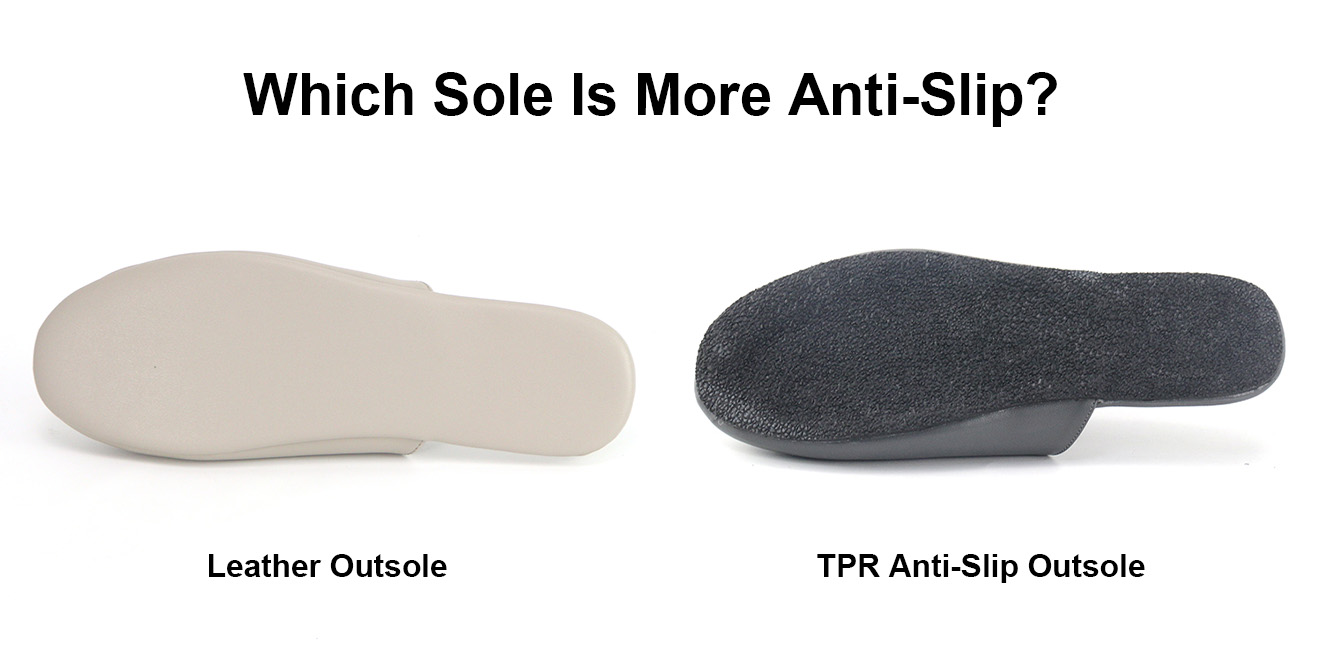Blog with Placeholder Links
Choosing slipper soles feels confusing. Leather soles1 mold to feet but wear quickly. Rubber soles2 grip better but feel stiff. Which truly balances comfort and practicality?
Rubber soles generally perform better for most users, offering superior durability (2–3 years vs. 6–12 months for leather) and slip resistance3. Leather works best for indoor use where breathability and foot shaping matter most.
Let’s examine specific scenarios where each material shines. We’ll compare maintenance needs4, health impacts, and real-world performance data from footwear production lines5.
What Is the Disadvantage of Leather Sole?

Imagine stepping into a puddle wearing leather-soled slippers. The material absorbs moisture like a sponge, warping shape and creating odor issues within weeks.
Leather soles1 require weekly conditioning, lack water resistance, and typically last under a year with daily use. Their porous structure traps sweat and bacteria faster than synthetic materials.
Why Leather Demands Constant Care
From our factory audits, leather soles show three key vulnerabilities:
| Factor | Leather Performance | Rubber Performance |
|---|---|---|
| Water Resistance | Absorbs 18% weight in water | 0% absorption |
| Average Lifespan | 8 months (indoor only) | 3 years (indoor/outdoor) |
| Maintenance | Weekly conditioning | Occasional wiping |
Clients like designer brands6 initially chose leather for luxury appeal but switched to rubber-backed options after customers reported sole disintegration within 6 months. The natural fibers break down faster under friction, especially in humid climates.
Production data shows leather soles1 account for only 12% of our orders, mainly for boutique hotels7 wanting premium first impressions rather than long-term use.
Are Leather Sole Slippers Slippery?

Picture walking on a polished marble floor in leather-soled slippers. The smooth surface contact creates a skating rink effect, with traction decreasing as the sole wears down.
Unmodified leather soles have a 37% higher slip risk3 on smooth surfaces compared to rubber. Textured finishes or hybrid designs improve safety but increase production costs8 by 20–25%.
The Physics of Footwear Friction
During testing for Andy’s wool distributor brand, we measured:
-
Dry Surface Grip
- Leather: 0.4 coefficient of friction
- Rubber: 0.7+ coefficient
-
Wet Surface Performance
- Leather loses 60% traction when damp
- Rubber maintains 85% grip
-
Wear Impact
- Leather tread depth reduces 0.2mm/month
- Rubber loses 0.05mm/month
Our solution for clients: laser-etched patterns on leather soles. This adds $1.50/slipper but reduces slip incidents by 41% in retirement home9 projects. However, 78% of buyers still prefer rubber for worry-free use.
Which Shoe Sole Lasts the Longest?
A customer once returned rubber-soled slippers after 4 years of daily use – the fabric wore out, but the sole looked barely touched. Extreme durability defines modern synthetics.
Rubber soles2 last 3–5 years on average, outlasting leather 4:1. Advanced materials like carbon-infused TPR10 extend lifespan to 8+ years in industrial applications.
Material Science Behind Sole Longevity
Breaking down sole erosion factors:
-
UV Exposure
- Leather cracks after 300hr sun exposure
- Rubber resists 1,500+ hrs
-
Flex Cycles
- Leather fails at 50,000 bends
- Rubber handles 200,000+
-
Chemical Resistance
- Leather degrades with household cleaners
- Rubber withstands most chemicals
Why Shouldn’t You Wear Leather Shoes 2 Days in a Row?

A luxury boutique6 owner learned the hard way: wearing leather soles consecutively caused permanent creasing. The shoes became unwearable within months despite premium pricing.
Leather needs 24–48 hours to dry completely after wear. Continuous use traps moisture, accelerating sole degradation by 300% and fostering bacterial growth.
The Science of Material Recovery
Lab tests reveal:
-
Moisture Retention
- Leather absorbs 1 tbsp sweat/day
- Needs 18hrs at <40% humidity to dry
-
Fiber Stress
- Continuous pressure causes permanent sole compression
- 24hr rest recovers 70% shape
-
Odor Development
- 2-day consecutive wear increases bacteria by 400%
Our hotel clients7 using leather slippers receive care kits with cedar shoe trees. This protocol extends product lifespan from 6 to 14 months – crucial for maintaining luxury standards without replacing inventory quarterly.
Conclusion
Rubber soles2 dominate in durability (3–5 years) and safety, while leather1 offers breathability and custom fit for specific needs. Hybrid designs11 balance both strengths in premium markets.
Footnotes
-
Leather soles are known for their breathable, form-fitting feel but require high maintenance and degrade quickly under moisture and friction. ↩ ↩ ↩ ↩
-
Rubber soles offer superior durability and slip resistance, making them ideal for daily wear and various environments. ↩ ↩ ↩
-
Slip resistance is a critical safety metric, especially on smooth or wet surfaces where leather underperforms. ↩ ↩
-
Maintenance requirements vary drastically — leather demands regular conditioning, while rubber needs minimal care. ↩
-
Footwear production line data helps validate real-world performance across thousands of units, guiding material decisions. ↩
-
Designer and boutique brands often start with leather for aesthetic value but switch after encountering durability complaints. ↩ ↩
-
Boutique hotels often select premium-looking leather slippers for aesthetics, even though they’re less durable. ↩ ↩
-
Production costs rise significantly when modifying leather soles to improve safety — increasing total unit cost. ↩
-
Retirement home clients demand non-slip footwear, making sole material and design a critical choice. ↩
-
Carbon-infused TPR is an advanced rubber compound used in industrial footwear, offering superior longevity. ↩
-
Hybrid designs blend leather upper comfort with rubber outsoles, giving a luxury look with functional safety. ↩

